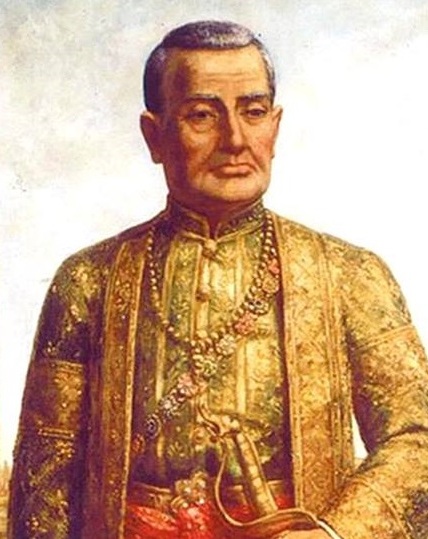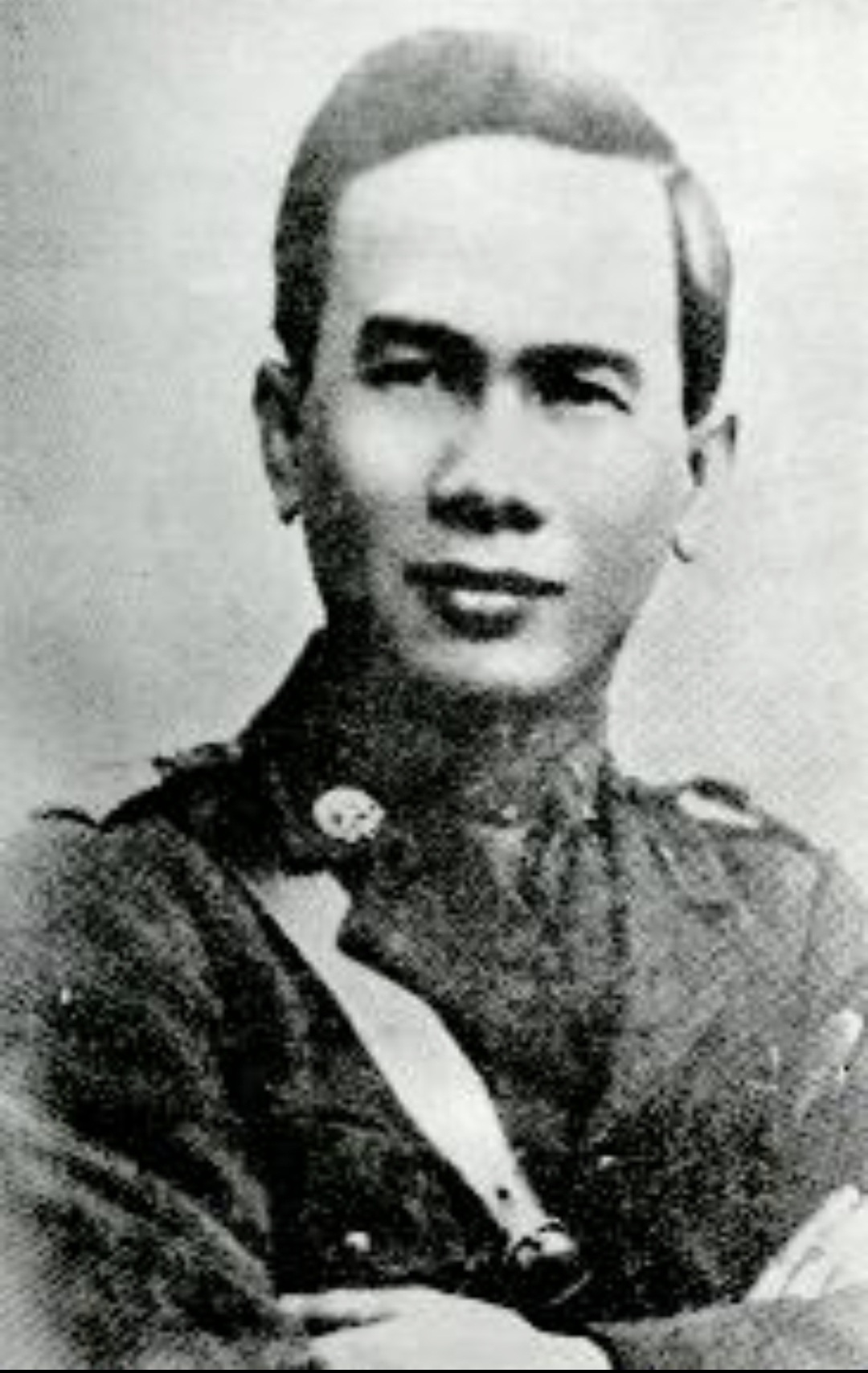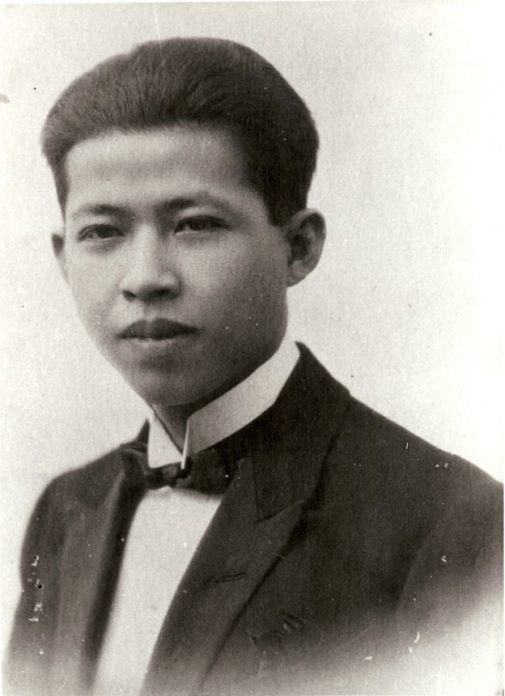|
Democracy Monument
The Democracy Monument () is a public monument in the city center of Bangkok, capital of Thailand. It occupies a traffic circle on the wide east‚Äďwest Ratchadamnoen Avenue, at the intersection of Dinso Road. The monument is roughly halfway between Sanam Luang, the former royal cremation ground in front of Wat Phra Kaew, and the temple of the Golden Mount (Phu Kao Thong). Once completed, Democracy Monument MRT station on MRT Purple Line and MRT Orange Line will serve the area. Commissioning The monument was commissioned in 1939 to commemorate the 1932 Siamese coup d'√©tat (also called "Siamese Revolution of 1932" or just "1932 Revolution") which led to the establishment of a constitutional monarchy in what was then the Kingdom of Siam, by its military ruler, Field Marshal Plaek Phibunsongkhram. Phibun saw the monument as the focal point of what he envisaged as a new, Westernized Bangkok, "making Thanon oadRatchadamnoen the Champs-√Člys√©es and the Democracy Monument the Arc ... [...More Info...] [...Related Items...] OR: [Wikipedia] [Google] [Baidu] |
Bowon Niwet Subdistrict
Bowon Niwet (, ) is a ''khwaeng'' (subdistrict) of Phra Nakhon District, in Bangkok, Thailand. In 2017 it had a total population of 4,837 people. Name and geography Bowon Niwet is considered to be the central part indented to the east of the Bangkok's old town zone or Rattanakosin Island. Its name comes from Wat Bowonniwet, a prominent local Buddhist temple. It covers important places (apart from Wat Bowonniwet) include Democracy Monument, Wat Ratchanaddaram and Satriwitthaya School as well as some parts of Bang Lamphu. Neighbourhoods Within the area of Bowon Niwet, there is a street in the form of ''soi'' (alley) named Trok Sake connecting Tanao Road with Atsadang Road in the vicinity of Royal Rattanakosin Hotel and Ratchadamnoen Avenue. Its area is along Klong Lot Wat Thep Thidaram, part of the old city moat, Khlong Khu Mueang Doem, and covers other short streets are Trok Sathien, Burana Sat Road, Bunsiri Road, Soi Damnoen Klang Tai. Trok Sake is considered one of the olde ... [...More Info...] [...Related Items...] OR: [Wikipedia] [Google] [Baidu] |
Wat Phra Kaew
Wat Phra Kaew (, , ), commonly known in English as the Temple of the Emerald Buddha and officially as Wat Phra Si Rattana Satsadaram, is regarded as the most sacred Wat, Buddhist temple in Thailand. The complex consists of a number of buildings within the precincts of the Grand Palace in the historical centre of Bangkok. It houses the statue of the Emerald Buddha, which is venerated as the country's Palladium (protective image), palladium. Construction of the temple began in 1783 under the orders of Rama I, the first king of the Chakri dynasty. Since then, each successive king has been personally involved in adding, restoring and embellishing the temple during their reigns as a way of making Merit (Buddhism), religious merit and glorifying the dynasty. Many important state and royal ceremonies are held within the temple each year, presided by King of Thailand, the king in person and attended by government officials. This makes the temple the nation's preeminent place of worship ... [...More Info...] [...Related Items...] OR: [Wikipedia] [Google] [Baidu] |
Corrado Feroci
Silpa Bhirasri (; ; ), born Corrado Feroci (15 September 1892 ‚Äď 14 May 1962), was an Italian-born Thai sculptor. He is considered the father of modern art in Thailand and was instrumental in the founding of today's Silpakorn University. Life Born in Florence, Tuscany, he studied at the Royal Art Academy of Florence and taught there from 1914 to 1923. Feroci was invited to Thailand in 1923 to teach Western sculpture at the Fine Arts Department of the Ministry of Palace Affairs. He was appointed as a sculptor in 1924 on a three-year contract for 800 baht per month. In 1943, he founded what later became Silpakorn University, the University of Fine Arts. When Italy surrendered to the Allies during World War II, Feroci changed his name and became a Thai national in 1944 to avoid arrest by the occupying Japanese army. Previously estranged from his wife in Italy, in his later years he married one of his Thai students. Feroci / Silpa was the designer and sculptor of many of Bangk ... [...More Info...] [...Related Items...] OR: [Wikipedia] [Google] [Baidu] |
Khuang Aphaiwong
Khuang Aphaiwong (also spelled Kuang, Abhaiwong and Abhaiwongse; , ; 17 May 1902 ‚Äď 15 March 1968), also known by his noble title Luang Kowit-aphaiwong (, ), was the founder of the Democrat Party and three times the prime minister of Thailand: from August 1944 to 1945, from January to May 1946, and from November 1947 to April 1948. Life and career Khuang was born in Battambang (a city in Cambodia), a son of the Siamese governor Chao Phraya Abhayabhubet. The Aphaiwongs were of royal Khmer lineage. Khuang attended Debsirin School and Assumption College, Bangkok, later studying engineering at the Ecole Centrale de Lyon in France. On his return to Thailand, he worked in the telegraph department, finally becoming director of the department. This earned him the feudal title '' Luang Kowit-aphaiwong''. He married Lekha Kunadilok (Goone-Tilleke), daughter of Ceylon-born lawyer William Alfred Goone-Tilleke, founder of the law firm Tilleke & Gibbins. Promoter of regime c ... [...More Info...] [...Related Items...] OR: [Wikipedia] [Google] [Baidu] |
Architect
An architect is a person who plans, designs, and oversees the construction of buildings. To practice architecture means to provide services in connection with the design of buildings and the space within the site surrounding the buildings that have human occupancy or use as their principal purpose. Etymologically, the term architect derives from the Latin , which derives from the Greek (''-'', chief + , builder), i.e., chief builder. The professional requirements for architects vary from location to location. An architect's decisions affect public safety, and thus the architect must undergo specialised training consisting of advanced education and a ''practicum'' (or internship) for practical experience to earn a Occupational licensing, license to practice architecture. Practical, technical, and academic requirements for becoming an architect vary by jurisdiction though the formal study of architecture in academic institutions has played a pivotal role in the development of the p ... [...More Info...] [...Related Items...] OR: [Wikipedia] [Google] [Baidu] |
Arc De Triomphe
The Arc de Triomphe de l'√Čtoile, often called simply the Arc de Triomphe, is one of the most famous monuments in Paris, France, standing at the western end of the Champs-√Člys√©es at the centre of Place Charles de Gaulle, formerly named Place de l'√Čtoile‚ÄĒthe ''√©toile'' or "star" of the juncture formed by its twelve radiating avenues. The location of the arc and the plaza is shared between three Arrondissements of Paris, arrondissements, 16th arrondissement of Paris, 16th (south and west), 17th arrondissement of Paris, 17th (north), and 8th arrondissement of Paris, 8th (east). The Arc de Triomphe honours those who fought and died for France in the French Revolutionary Wars, French Revolutionary and Napoleonic Wars, with the names of all French victories and generals inscribed on its inner and outer surfaces. Beneath its vault lies the Tomb of the Unknown Soldier (France), Tomb of the Unknown Soldier from World War I. The central cohesive element of the ''Axe historique'' ( ... [...More Info...] [...Related Items...] OR: [Wikipedia] [Google] [Baidu] |
Champs-√Člys√©es
The Avenue des Champs-√Člys√©es (, ; ) is an Avenue (landscape), avenue in the 8th arrondissement of Paris, France, long and wide, running between the Place de la Concorde in the east and the Place Charles de Gaulle in the west, where the Arc de Triomphe is located. It is known for its theatres, caf√©s, and luxury shops; as the finish of the Tour de France cycling race; and for its annual Bastille Day military parade. The name is French for the Elysium, Elysian Fields, the place for dead heroes in Greek mythology. It has been described as the "most beautiful avenue in the whole world". Description The avenue runs for through the 8th arrondissement of Paris, 8th arrondissement in northwestern Paris, from the Place de la Concorde in the east, with the Luxor Obelisks, Obelisk of Luxor, to the Place Charles de Gaulle (formerly the ''Place de l'√Čtoile'') in the west, location of the Arc de Triomphe. The Champs-√Člys√©es forms part of the ''Axe historique''. The lower part of t ... [...More Info...] [...Related Items...] OR: [Wikipedia] [Google] [Baidu] |
Westernized
Westernization (or Westernisation, see spelling differences), also Europeanisation or occidentalization (from the ''Occident''), is a process whereby societies come under or adopt what is considered to be Western culture, in areas such as industry, technology, science, education, politics, economics, lifestyle, law, norms, mores, customs, traditions, values, mentality, perceptions, diet, clothing, language, writing system, religion, and philosophy. During colonialism it often involved the spread of Christianity. A related concept is Northernization, which is the consolidation or influence of the Global North. Westernization has been a growing influence across the world in the last few centuries, with some thinkers assuming Westernization to be the equivalent of modernization, a way of thought that is often debated. The overall process of Westernization is often two-sided in that Western influences and interests themselves are joined with parts of the affected society, at minimum, ... [...More Info...] [...Related Items...] OR: [Wikipedia] [Google] [Baidu] |
Plaek Phibunsongkhram
Plaek Phibunsongkhram; 14 July 1897 ‚Äď 11 June 1964) was a Thai military officer and politician who served as the third prime minister of Thailand from 1938 to 1944 and again from 1948 to 1957. He rose to power as a leading member of the Khana Ratsadon, becoming prime minister in 1938 and later consolidating his influence as a military dictator. His regime allied with the Empire of Japan during the Second World War, and his administration was marked by authoritarian policies and the promotion of Thai nationalism. He was closely involved in both domestic reforms and foreign policy during the war and played a central role in shaping modern Thai state ideology. Phibun was a member of the army wing of Khana Ratsadon, the first political party in Thailand, and a leader of the Siamese revolution of 1932, which replaced Thailand's absolute monarchy with a constitutional monarchy. Phibun became the third Prime Minister of Thailand in 1938 while serving as Commander of the Royal ... [...More Info...] [...Related Items...] OR: [Wikipedia] [Google] [Baidu] |
Constitutional Monarchy
Constitutional monarchy, also known as limited monarchy, parliamentary monarchy or democratic monarchy, is a form of monarchy in which the monarch exercises their authority in accordance with a constitution and is not alone in making decisions. Constitutional monarchies differ from absolute monarchies (in which a monarch is the only decision-maker) in that they are bound to exercise powers and authorities within limits prescribed by an established legal framework. A constitutional monarch in a parliamentary democracy is a hereditary symbolic head of state (who may be an emperor, king or queen, prince or grand duke) who mainly performs representative and civic roles but does not exercise executive or policy-making power. Constitutional monarchies range from countries such as Liechtenstein, Monaco, Morocco, Jordan, Kuwait, Bahrain and Bhutan, where the constitution grants substantial discretionary powers to the sovereign, to countries such as the United Kingdom and other Com ... [...More Info...] [...Related Items...] OR: [Wikipedia] [Google] [Baidu] |
1932 Siamese Coup D'état
The Siamese revolution of 1932 or Siamese coup d'état of 1932 ( or ) was a coup d'état by the People's Party which occurred in Siam on 24 June 1932. It ended Siam's centuries-long absolute monarchy rule under the Chakri dynasty and resulted in a bloodless transition of Siam into a constitutional monarchy, the introduction of democracy and the first constitution, and the creation of the National Assembly. Dissatisfaction caused by the economic crisis, the lack of a competent government, and the rise of Western-educated commoners fueled the revolution. King Prajadhipok remained on the throne and compromised with Khana Ratsadon. Two coups occurred a year later, in April and June amid infighting within the government over Pridi Banomyong's socialist economic plan and a rebellion of the royalists. Background Absolute monarchy Since 1782, the Kingdom of Siam had been ruled by the Chakri dynasty. After 1868, King Chulalongkorn (Rama V) reformed a medieval kingdom into a cen ... [...More Info...] [...Related Items...] OR: [Wikipedia] [Google] [Baidu] |
MRT Orange Line
The MRT Orange Line () is a rapid transit line of the Mass Rapid Transit Authority of Thailand (MRTA) in the Bangkok Metropolitan Area, Thailand. When fully completed, the MRT Orange line will be long with 29 stations (7 stations will be elevated for and 22 will be underground for ), including an interchange with the current Thailand Cultural Centre Station of MRT Blue Line). The MRT Orange Line is divided into two sections: the Eastern Section, running from Yaek Rom Klao to Thailand Cultural Centre, and the Western Section, extending from Thailand Cultural Centre to Bang Khun Non. Construction of the Eastern Section commenced in June 2017, and civil works were completed 100% as of June 2023. However, delays in awarding contracts for the signaling systems and rolling stock postponed the line’s opening. In December 2024, Bangkok Expressway and Metro Public Company Limited (BEM) signed a contract with Siemens Mobility and its consortium partners to supply rolling stock an ... [...More Info...] [...Related Items...] OR: [Wikipedia] [Google] [Baidu] |





